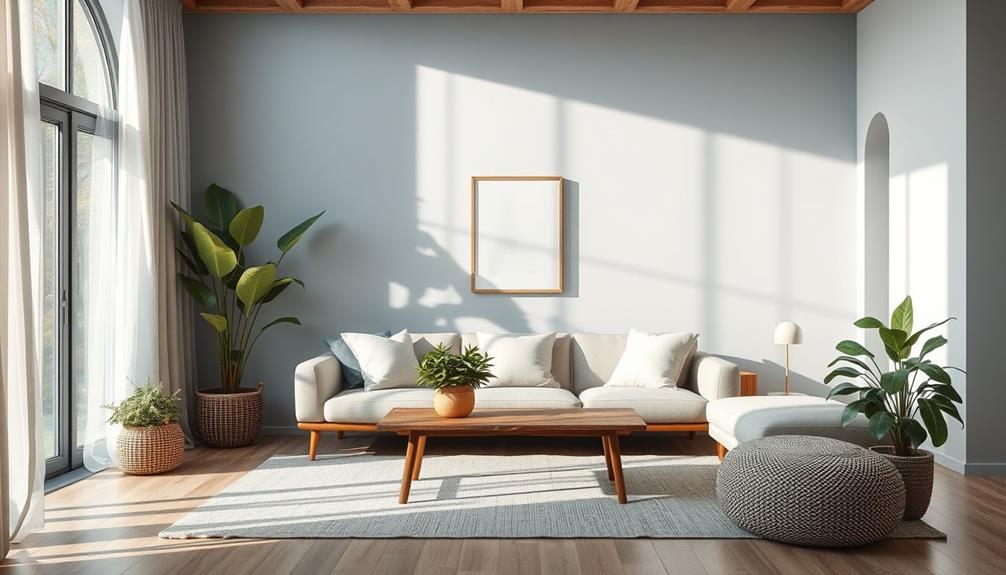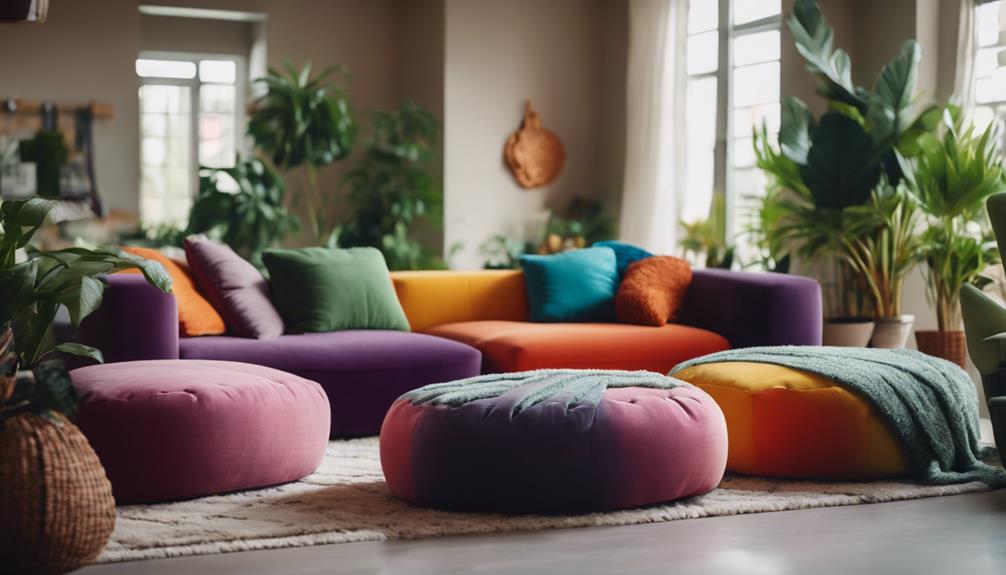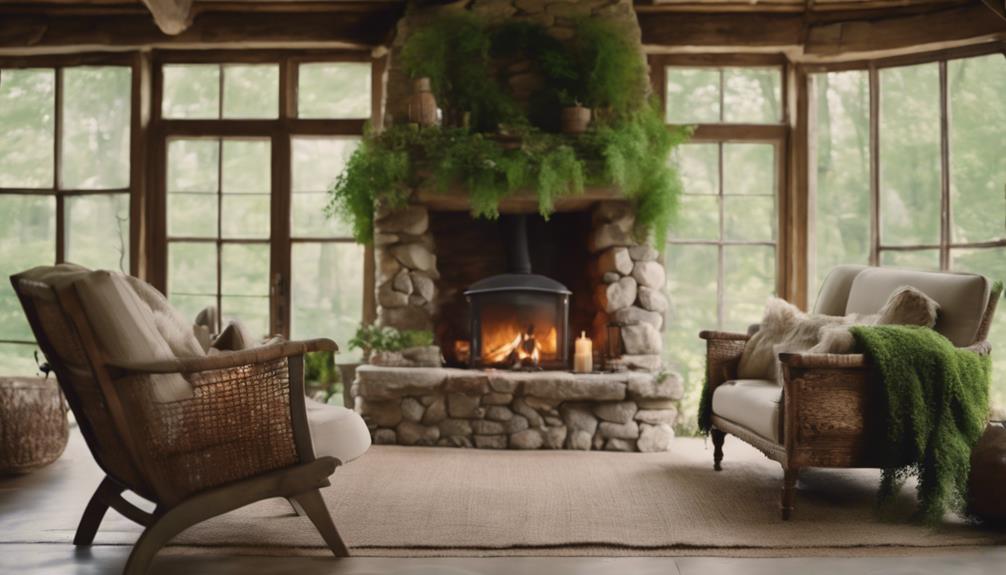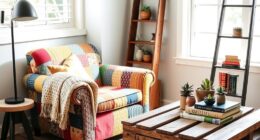Color psychology plays an essential role in interior design, influencing how you feel in your space. Warm tones like red and orange can energize you, while cool tones like blue and green promote tranquility. To create the right ambiance, think about your space's purpose. Use the 60-30-10 rule for color distribution; this balances dominant, secondary, and accent colors effectively. Experiment with different combinations and lighting to find what works best. Choosing the right palette can transform your environment, making it vibrant and inviting. Explore these insights further to discover how color can redefine your living space. Additionally, incorporating dark wall design techniques can add depth and drama to your space. Consider using deep navy or charcoal tones to create a sense of coziness and intimacy in large rooms, or try accenting with dark, textured wallpaper for a luxurious touch. By understanding the power of color psychology and implementing effective design strategies, you can truly transform your environment into a place that evokes the emotions and experiences you desire.
Key Takeaways
- Understanding color psychology helps select colors that evoke desired emotions and enhance mood in interior spaces.
- Use the 60-30-10 rule for balanced color schemes, allocating dominant, secondary, and accent colors appropriately.
- Complementary color pairings create dynamic atmospheres, while analogous schemes promote a calming environment.
- Test color samples under different lighting conditions to ensure the desired effect in your space.
- Stay updated on color trends through design platforms and blogs to create fresh, inviting interiors.
Importance of Color in Design
Color is crucial in interior design, shaping how we feel and interact with our surroundings. The colors you choose can greatly influence the atmosphere and character of your space.
Light colors create the illusion of larger areas, while dark hues evoke warmth and intimacy. By selecting effective color schemes, you can transform dull environments into vibrant reflections of your personality and the purpose of each room. Additionally, incorporating elements like neutral color palettes can enhance the overall aesthetic of a farmhouse-inspired design.
Understanding color psychology is essential in this process. For instance, warm tones like red and orange can energize and stimulate, perfect for active areas, whereas cool tones like blue and green promote calmness and relaxation, ideal for bedrooms or reading nooks.
Using the color wheel can further aid your choices, allowing you to create visually appealing combinations. Complementary colors provide strong contrasts that grab attention, while analogous colors foster a harmonious aesthetic.
Understanding Color Psychology
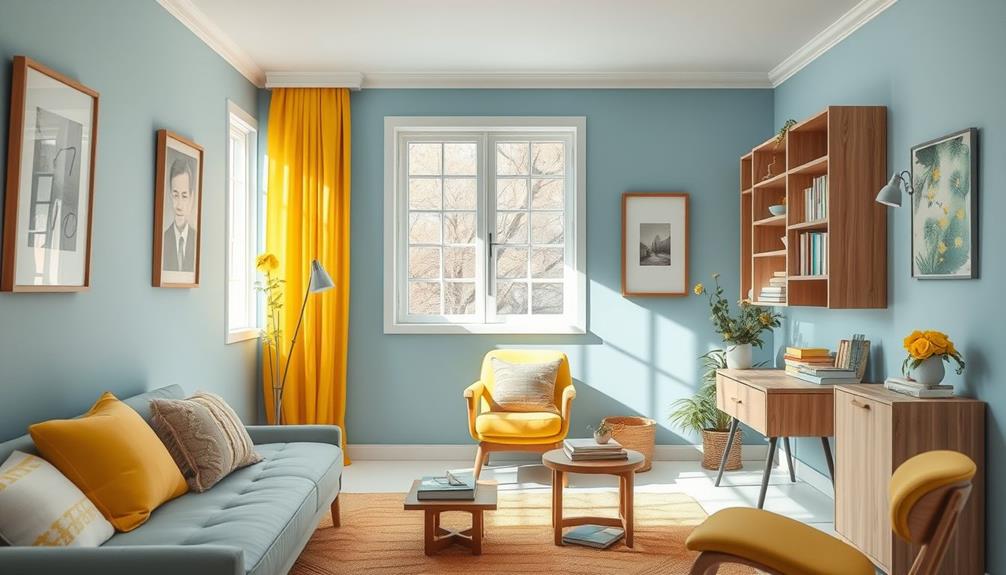
Choosing the right hues isn't just about aesthetics; it's also about how those colors impact your feelings and behaviors. Understanding color psychology is essential for creating spaces that resonate with your emotions.
Different colors evoke distinct feelings, influencing everything from your mood to your productivity. Additionally, the ambiance created by color can enhance your overall well-being, similar to how certain signs are viewed as more appealing socially.
Consider these psychological effects of different colors when you choose colors for your space:
- Red: Energizes and stimulates creativity.
- Blue: Promotes calmness and tranquility.
- Yellow: Inspires happiness and optimism.
- Green: Encourages balance and rejuvenation.
- Orange: Boosts enthusiasm and warmth.
Effective Color Combinations
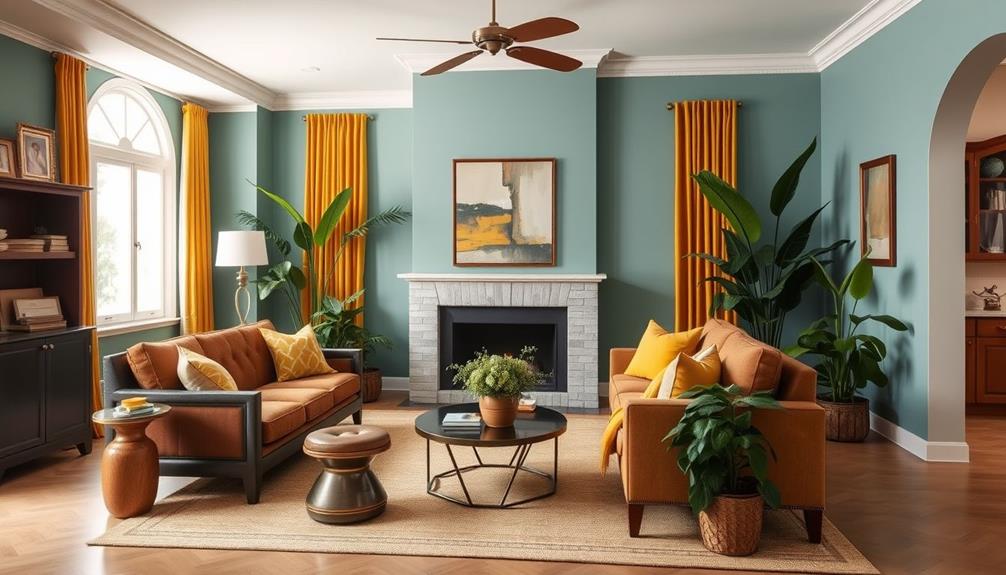
When choosing colors for your space, consider how different combinations can impact the mood and energy.
Incorporating elements of modern farmhouse bedroom design can enhance the feel of your palette, promoting a serene and inviting atmosphere.
Complementary colors can energize a room, while analogous schemes promote a calming atmosphere.
Triadic color palettes offer a vibrant balance, making them perfect for dynamic areas where creativity flows.
Complementary Color Pairings
Complementary color pairings can transform your space into a vibrant and engaging environment. By using colors like blue and orange or red and green, you can create strong contrasts that energize your surroundings and highlight specific design elements.
These combinations enhance visual interest and foster a dynamic atmosphere, perfect for social areas like living rooms or kitchens. Additionally, selecting colors that resonate with the emotional tone of your space can enhance personal growth and relationship dynamics, aligning with insights from June 2025 Horoscope Predictions.
To effectively use complementary colors, consider the following tips:
- Balance their application (60% dominant color, 30% complementary, 10% neutral).
- Test colors under various lighting conditions to see how they interact.
- Pair calming colors with energizing ones to evoke specific emotional responses.
- Utilize these pairings to draw attention to architectural features or decor.
- Experiment with shades and tints to find the right intensity.
When done right, complementary colors don't just make your space pop; they also create a mood that invites interaction and comfort.
Analogous Color Harmony
Analogous color harmony offers a soothing and cohesive aesthetic by combining three colors that sit next to each other on the color wheel, like blue, blue-green, and green. This scheme evokes feelings of tranquility and comfort, making it perfect for spaces designed for relaxation, such as bedrooms or reading nooks. To create a cohesive look, utilize a dominant color for about 60% of the space, supported by secondary and accent colors at 30% and 10%, respectively.
| Color | Psychological Effect | Usage Example |
|---|---|---|
| Blue | Calming and serene | Walls or larger furniture |
| Blue-Green | Invigorating and revitalizing | Accent pieces or textiles |
| Green | Restorative and harmonious | Plants or decor elements |
Maintaining visual interest is essential, so incorporate various shades, tints, and tones of your chosen colors to add depth and dimension. Finally, don't forget to test your analogous color combination under various lighting conditions, as the psychological effects of different colors can shift dramatically with light.
Triadic Color Balance
Here are some tips for effective triadic color combinations:
- Select colors evenly spaced on the color wheel for the best effect. Incorporating cozy teenage girl room colors can help create a soothing environment that complements your triadic scheme.
- Test combinations in various lighting to see how they change throughout the day.
- Use red, blue, and yellow for a dynamic, energetic atmosphere, ideal for creative spaces.
- Incorporate your dominant color in larger areas, like walls or furniture.
- Consider your space's purpose, as triadic schemes work well in social areas like living rooms.
Tips for Selecting a Palette
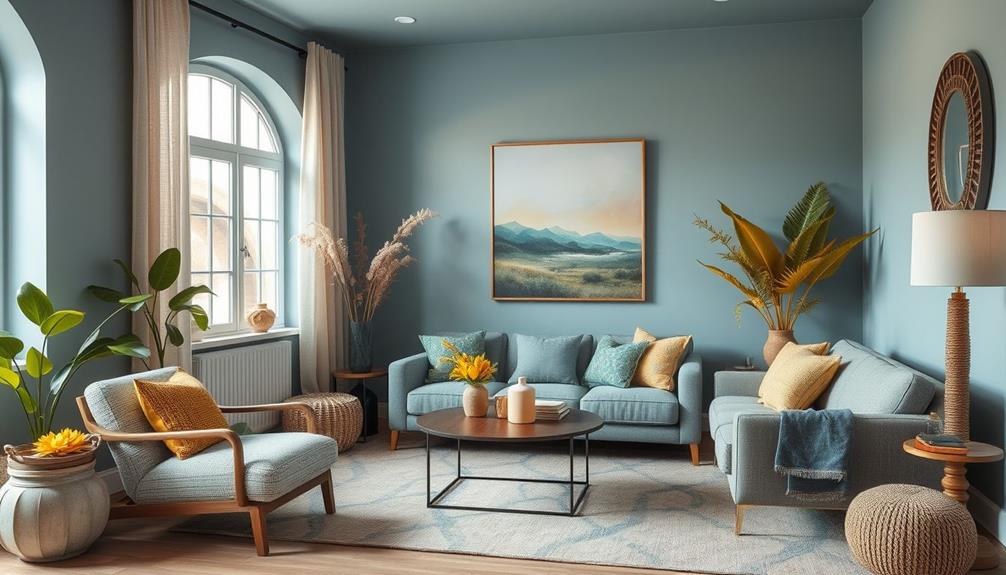
When you're selecting a color palette for your space, it's essential to first consider its intended purpose, as this will greatly influence your choices.
Think about how you want to feel in that room—whether it's for relaxation, productivity, or entertainment. Understanding color psychology can guide you; for instance, calming blues work well in bedrooms, while vibrant yellows can stimulate appetite in kitchens.
Additionally, incorporating decorative elements such as stylish wall clocks can complement your chosen colors and enhance the overall atmosphere of the space.
Next, pay attention to ambient lighting. Colors can look vastly different under various lighting conditions, so it's wise to test samples in the light you'll be using most often. This guarantees you get an accurate sense of how the colors will appear.
Define your decoration style, as this can help create a cohesive look throughout your space.
To achieve visual balance, consider the 60-30-10 rule: allocate 60% of your space to a dominant color, 30% to a secondary color, and 10% to an accent color. This structure helps in selecting a palette that feels harmonious and inviting.
Trends in Color Selection
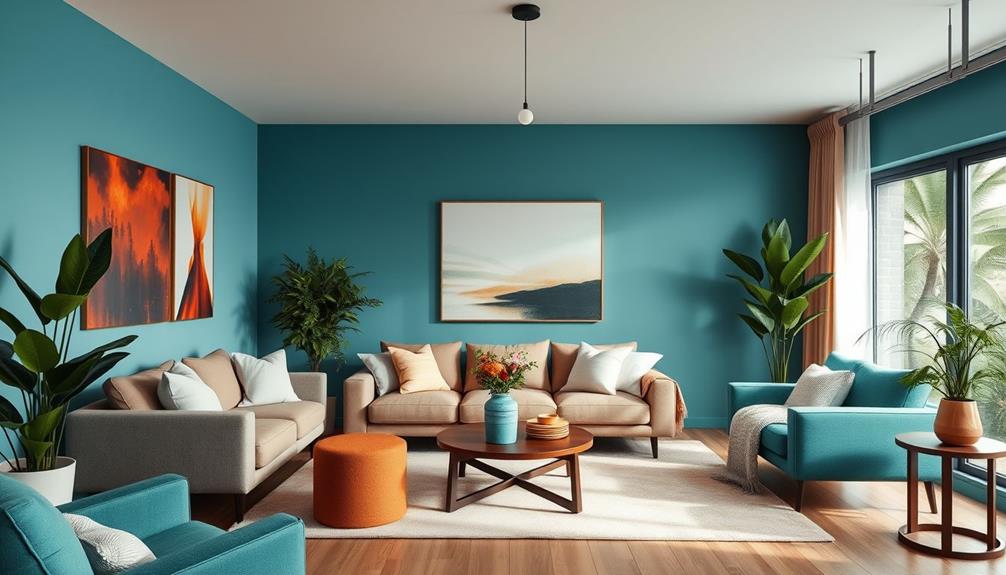
Color trends in interior design are constantly evolving, shaped by cultural shifts and societal influences. Staying updated on these trends can help you create spaces that feel fresh and inviting. Organizations like Pantone play a significant role in establishing annual color trends, influencing your choices as a designer.
Additionally, incorporating elements like garage door openers can enhance the overall aesthetic of a space through modern technology and style. You'll notice seasonal trends reflecting nature's changes—warmer tones like terracotta and earthy browns dominate in fall and winter, while cooler, vibrant hues such as turquoise and pastel greens come alive in spring and summer.
Here are some current trends to take into account for your color palette:
- Earthy tones promoting warmth and comfort
- Sustainable materials that reflect eco-consciousness
- Bold accent colors for a modern twist
- Neutral shades for timeless elegance
- Layering textures to enhance color depth
While it's tempting to chase fleeting trends, remember that client preferences should guide your color selections. Balancing trendy colors with timeless shades guarantees your designs remain both functional and appealing in the long run.
Embrace current trends, but always prioritize personal touches that resonate with those who inhabit the space.
Resources for Design Inspiration

When you're searching for design inspiration, online platforms and blogs are your best friends. They not only showcase the latest trends but also offer a wealth of color palettes and ideas, including tailored solutions for unique needs in your space.
Engaging with design communities on social media can further enrich your choices, allowing you to share and receive valuable feedback.
Additionally, resources like the Études Architect App facilitate collaboration among architects and designers, enhancing your design journey.
Online Design Platforms
In today's digital age, online design platforms have become essential resources for anyone looking to revamp their space.
These platforms offer a treasure trove of inspiration, helping you explore various styles and color palettes while deepening your understanding of interior design color psychology. For example, you might discover how to enhance your health and well-being through mindful design choices that incorporate natural elements, similar to sustainability and ethical sourcing in other industries.
Here are some key features to take into account:
- Visual Inspiration: Browse through countless images curated by professionals and enthusiasts.
- Mood Board Creation: Use tools to create mood boards, experimenting with different color combinations before committing.
- Guides and Articles: Access extensive resources that explain how colors influence mood and atmosphere.
- Design Communities: Connect with experts and fellow design lovers on platforms like Instagram and Facebook for collaboration and feedback.
- Exclusive Content: Subscription services often provide curated color palettes and seasonal trend reports to keep you updated.
Inspirational Interior Design Blogs
Finding inspiration for your interior design projects can be as simple as exploring the wealth of resources available online. Inspirational interior design blogs like Apartment Therapy and Design*Sponge provide curated galleries, DIY projects, and expert advice that can help you choose the perfect color palettes for your space.
These blogs often investigate color psychology, explaining how different hues can affect mood and atmosphere, allowing you to create an environment that resonates with you. Additionally, understanding design principles such as the balance of design thinking can guide your color choices to enhance both aesthetics and functionality.
Don't overlook platforms like Pinterest, where you can discover and save a vast array of color schemes tailored to your preferences. Following leading design influencers through their blogs and social media offers fresh perspectives on the latest color trends and innovative applications in design.
To stay updated, consider subscribing to newsletters from reputable design websites. This way, you'll receive regular insights on current color trends, tips, and inspiration straight to your inbox.
Design Community Engagement
Design community engagement offers a dynamic way to ignite your creativity and stay current with the latest trends in color palettes for your interior projects. By connecting with others in the design field, you can enhance your understanding and application of color trends.
Here are some effective ways to immerse yourself in the design community:
- Explore platforms like Pinterest and Instagram for a treasure trove of visual inspiration and trending color palettes.
- Join online forums and groups dedicated to interior design, allowing for collaborative idea sharing and gaining feedback from fellow designers.
- Subscribe to influential design blogs and newsletters to stay updated on the latest color trends and practical applications.
- Attend local design workshops and events to network with industry professionals and learn effective color selection strategies.
- Browse catalogs from design companies to discover the latest materials and innovative color combinations.
Engaging with these resources not only broadens your perspective but also helps you implement color palettes that resonate with your vision, ensuring your interiors reflect both current trends and your unique style.
Frequently Asked Questions
How Do I Choose the Right Color Palette for My Interior?
To choose the right color palette for your interior, consider the room's purpose, apply the 60-30-10 rule, test colors in different lights, and explore combinations for balance and mood enhancement. Trust your instincts!
What Is the 3 Color Rule in Interior Design?
Did you know that using just three colors can make a room feel 60% more balanced? The 3 Color Rule suggests a dominant color for 60%, a secondary for 30%, and an accent for 10%.
What Is Color Psychology in Interior Spaces?
Color psychology in interior spaces explores how colors affect your emotions and behaviors. By selecting the right hues, you can create an atmosphere that energizes, calms, or uplifts, enhancing your experience in that environment.
What Are the Psychological Colors of the Palette?
The psychological colors of the palette include red for energy, blue for calmness, yellow for happiness, green for harmony, and purple for luxury. Each color influences mood and atmosphere, helping you create the desired space.
Conclusion
As you commence your design journey, remember that the right color palette can transform your space and mood. It's fascinating how a simple hue can evoke memories, energize your mornings, or create a cozy retreat at night. When you blend colors thoughtfully, you'll find that your surroundings can reflect your personality and aspirations. So, take a moment to explore and experiment; you might just discover the perfect shades that resonate with your unique style.
